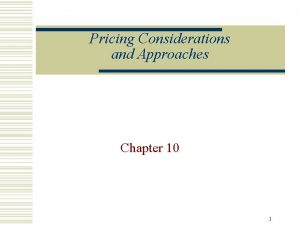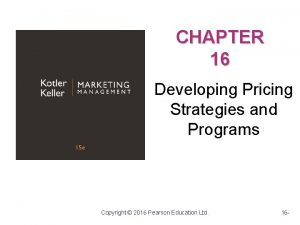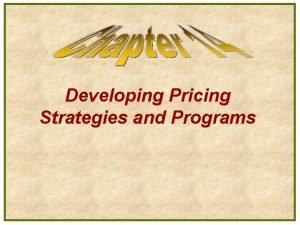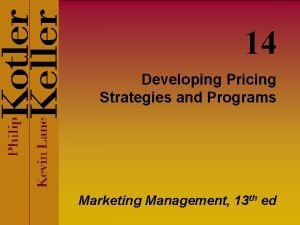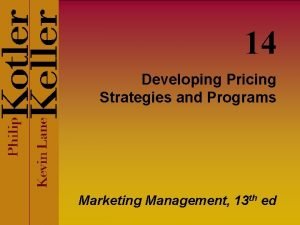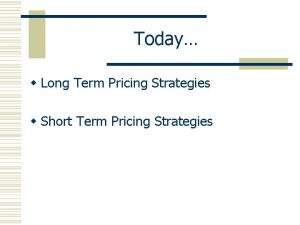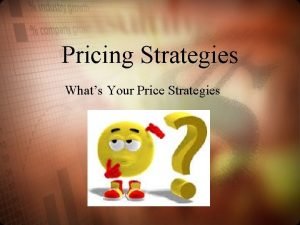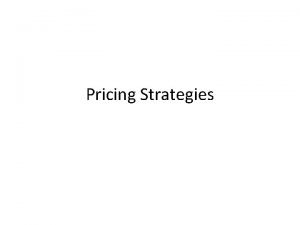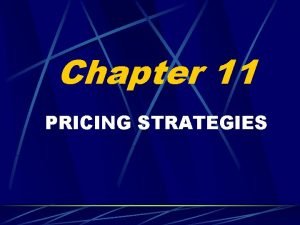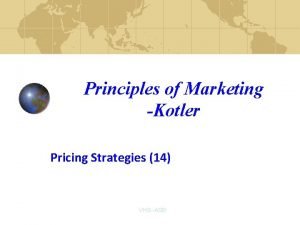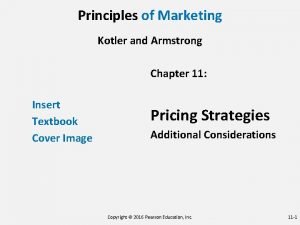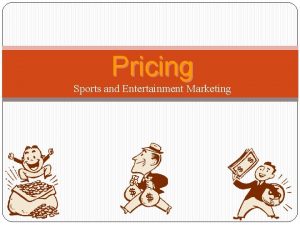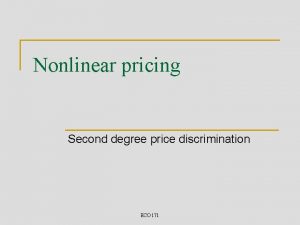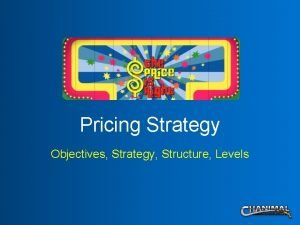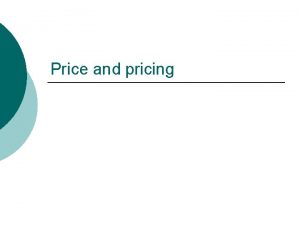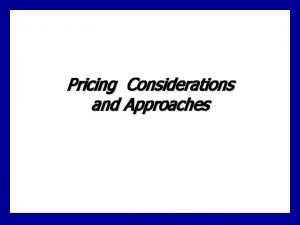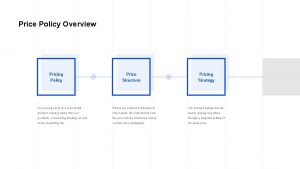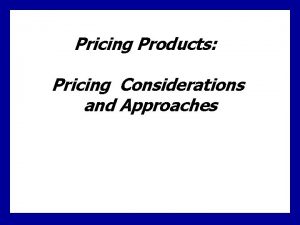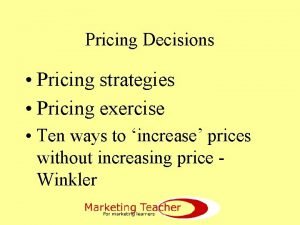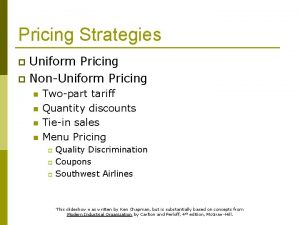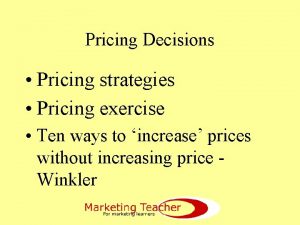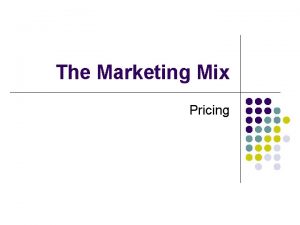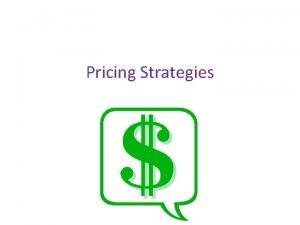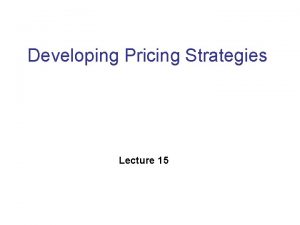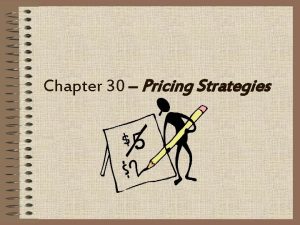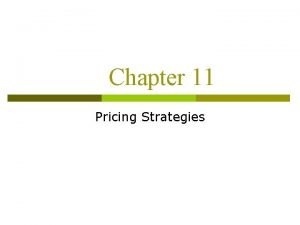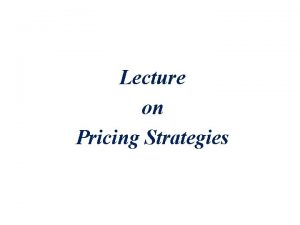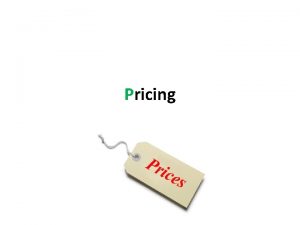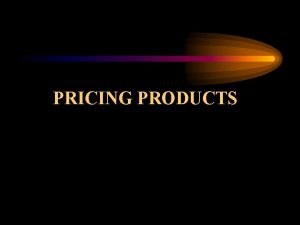Pricing Approaches and Strategies Price o The amount


























- Slides: 26

Pricing: Approaches and Strategies

Price o The amount of money charged for a product, or the sum of the values that consumers exchange for the benefits of having/using the product or service. o Price and the Marketing Mix • Only element to produce revenues • Most flexible element • Can be changed quickly o Price as a tool of Competition o Common Pricing Mistakes

Factors to Consider in Setting Price Inte rnal Fac to rs o o Marketing objectives Marketing mix strategies Costs Organizational considerations o Market positioning influences pricing strategy o Other pricing objectives: • • Survival Current profit maximization Market share leadership Product quality leadership o Not-for-profit objectives: • Partial or full cost recovery • Social pricing

Factors to Consider in Setting Price (contd. ) Inte rnal Fac to rs o o Marketing objectives Marketing mix strategies Costs Organizational considerations o Pricing must be carefully coordinated with the other marketing mix elements o Target costing is often used to support product positioning strategies based on price o Non-price positioning can also be used

Factors to Consider in Setting Price (contd. ) Inte rnal Fac to rs o o Marketing objectives Marketing mix strategies Costs Organizational considerations o Types of costs: • Variable • Fixed • Total costs o How costs vary at different production levels will influence price setting o Experience (learning) curve effects on price

Strategic Impact & Cost Analysis: Pareto Law Effect Citi. Bank NA Example o If you successfully improve 20% of the most important problems, you will gain the same effect as you would by improving the rest 80%. This represents a big advantage with respect to cost versus effect. 80% 20% No. of Services 80% No. of Customers Customer Accounts for purification Service Range for Rationalization o There are only few things that are really important. Customer Revenue o 80% of Cost Structure on staff and even Marketing Expenses is caused by 20% of Accounts for their Low Deposits and high Transaction Volume. Service Revenue Customer/ Service for Elimination Figure: Customer/Service Revenue Matrix For an Effective Cost-Structure: o 20% of the Customers and 20% of the Services contribute 80% of Revenue. o Rationalize 80% services & Purify 80% Accounts as they contribute only 20% of revenue. o Eliminate Services & Accounts in the Bottom-Right-Cell as they are certainly running at a loss.

Factors to Consider in Setting Price (contd. ) Inte rnal Fac to rs o o Marketing objectives Marketing mix strategies Costs Organizational considerations o Who sets the price? • In Small companies: CEO or top management • In Large companies: Divisional or product line managers o Price negotiation is common in industrial settings o Some industries have pricing departments

Factors to Consider in Setting Price (contd. ) Exte rnal Fac to rs o Nature of market and demand o Competitors’ costs, prices, and offers o Other environmental elements o Types of markets • Pure competition • Monopolistic competition • Oligopolistic competition • Pure monopoly o Consumer perceptions of price and value o Price-demand relationship • Demand curve • Price elasticity of demand

Factors to Consider in Setting Price (contd. ) Exte rnal Fac to rs o Nature of market and demand o Competitors’ costs, prices, and offers o Other environmental elements o Consider competitors’ costs, prices, and possible reactions when developing a pricing strategy o Pricing strategy influences the nature of competition • Low-price low-margin strategies inhibit competition • High-price high-margin strategies attract competition o Benchmarking costs against the competition is recommended

Factors to Consider in Setting Price (contd. ) Exte rnal Fac to rs o Nature of market and demand o Competitors’ costs, prices, and offers o Other environmental elements o Economic conditions • Affect production costs • Affect buyer perceptions of price and value o Reseller reactions to prices must be considered o Government may restrict or limit pricing options o Social considerations may be taken into account

General Pricing Approaches 1. Cost-Based Pricing: a) Cost-Plus Pricing • Adding a standard markup to cost • Ignores demand competition • Popular pricing technique because: • It simplifies the pricing process Price • competition may be minimized • It is perceived as more fair to both buyers and sellers Example Variable costs: Tk. 20 Expected sales: 100, 000 units Fixed costs: Tk. 500, 000 Desired Sales Markup: 20% Variable Cost + Fixed Costs/Unit Sales = Unit Cost Tk. 20 + Tk. 500, 000/100, 000 = Tk. 25 per unit Unit Cost/(1 – Desired Return on Sales) = Markup Price Tk. 25 / (1 -. 20) = Tk. 31. 25

General Pricing Approaches (contd. ) b) Break-Even Analysis & Target Profit Pricing o Break-even charts show total cost and total revenues at different levels of unit volume. o The intersection of the total revenue and total cost curves is the break-even point. o Companies wishing to make a profit must exceed the break-even unit volume. Revenues Thousands Taka 1000 Target Profit Tk. 200, 000 800 Total Costs Break-even point 600 400 Fixed Costs 200 0 10 20 30 40 Sales Volume in Thousands of Units Quantity To Be Sold To Meet Target Profit

General Pricing Approaches (contd. ) 2. Value-Based Pricing o Uses buyers’ perceptions of value rather than seller’s costs to set price. o Business-to-business firms seek to retain o Measuring perceived value pricing power can be difficult. • Value-added strategies can help o Consumer attitudes toward price and quality have o Value pricing at the shifted during the last retail level decade. • Everyday low pricing • Introduction of less expensive versions of established brands has become common. (EDLP) vs. high-low pricing

General Pricing Approaches (contd. ) 3. Competition-Based Pricing • Also called going-rate pricing • May price at the same level, above, or below the competition • Bidding for jobs is another variation of competition - based pricing • Sealed bid pricing

Other Pricing Approaches o Market-Skimming Pricing • Setting a high price for a new product to skim maximum revenues layer by layer from segments willing to pay the high price. o Market-Penetration Pricing • Setting a low price for a new product in order to attract a large number of buyers and a large market share. o Market Rate Pricing • Ceding the initiative to the key competitors to set the price. • Dangerous for leaving the strategic initiative to competitors • Potential threat of ‘Sudden Price Shift’ by newer, or ‘Changes in delivery system capability’. o Relationship Pricing • Different price for Different class of customers depending on relationship and the potentiality of cross-selling or future business.

Product Mix Pricing Strategies o Product Line Pricing • Setting price steps between product line items. • Line of products rather single one • Price points o Optional-Product Pricing • Pricing optional or accessory products sold with the main product o By-Product Pricing • Pricing low-value by-products to get rid of them o Captive-Product Pricing • Pricing products that must be used with the main product • High margins are often set for supplies • Services: two-part pricing strategy • Fixed fee plus a variable usage rate o Product Bundle Pricing • Pricing bundles of products sold together

Price Adjustment Strategies S trate g ie s o o Discount / allowance Segmented Psychological Promotional o Types of discounts Cash discount and • Quantity discount • • Functional (trade) discount • Seasonal discount o Allowances • Trade-in allowances • Promotional allowances

Price Adjustment Strategies (contd. ) S trate g ie s o o Discount / allowance Segmented Psychological Promotional o Types of segmented pricing strategies: • Customer-segment • Product-form pricing • Location pricing • Time pricing o Also called revenue or yield management o Certain conditions must exist for segmented pricing to be effective

Conditions Necessary for Segmented Pricing Effectiveness o Market is segmentable o Pricing must be legal o Lower priced segments are not able to resell o Costs of segmentation can not exceed revenues earned o Competitors can not undersell segments charging higher prices o Segmented pricing must reflect real differences in customers’ perceived value

Price Adjustment Strategies (contd. ) S trate g ie s o o Discount / allowance Segmented Psychological Promotional o The price is used to say something about the product. • Price-quality relationship • Reference prices • Differences as small as five cents can be important • Numeric digits may have symbolic and visual qualities that psychologically influence the buyer • Odd • rounding

Price Adjustment Strategies (contd. ) S trate g ie s o o Discount / allowance Segmented Psychological Promotional o Temporarily pricing products below the list price or even below cost o Loss leaders • Special-event pricing • Cash rebates • Low-interest financing, longer warranties, free maintenance o Promotional pricing can have adverse effects

Promotional Pricing Problems o Easily copied by competitors o Creates deal-prone consumers o May erode brand’s value o Not a legitimate substitute for effective strategic planning o Frequent use leads to industry price wars which benefit few firms

Price Discrimination o Customer Discrimination • for students only o Product-form Discrimination • Telecom products o Place Discrimination • service at ATM versus at counters o Time Discrimination • peak -hours/ off-peak-hours

Price Changes o Initiating Price Cuts is Desirable When a Firm • Has excess capacity • Faces falling market share due to price competition • Desires to be a market share leader o Price Increases are Desirable • If a firm can increase profit, faces cost inflation, or faces greater demand than can be supplied. o Methods of Increasing Price o Alternatives to Increasing Price • Reducing product size, using less expensive materials, unbundling the product.

Price Changes (contd. ) o Buyer reactions to price changes must be considered. o Competitors are more likely to react to price changes under certain conditions. • Number of firms is small • Product is uniform • Buyers are well informed o Respond to Price Changes only if: • Market share / profits will be negatively affected if nothing is changed. • Effective action can be taken: • • Reducing price Raising perceived quality Improving quality and increasing price Launching low-price “fighting brand”

Public Policy and Pricing o Pricing within Channel Levels • Price-fixing • Competitors can not work with each other to set prices • Predatory pricing • Firms may not sell below cost with the intention of punishing a competitor or gaining higher long-run profits or running a competitor out of business. o Pricing across Channel Levels • Price discrimination • Retail price maintenance • Deceptive pricing • Bogus reference / comparison pricing • Scanner fraud • Price confusion
 Ito ay kilala rin bilang maximum price policy
Ito ay kilala rin bilang maximum price policy Pricing considerations and approaches
Pricing considerations and approaches General pricing approaches
General pricing approaches Pricing approaches
Pricing approaches Global pricing and distribution strategies
Global pricing and distribution strategies Developing price strategies and programs
Developing price strategies and programs Global pricing objectives and strategies
Global pricing objectives and strategies Developing pricing strategies and programs
Developing pricing strategies and programs Developing pricing strategies and programs
Developing pricing strategies and programs Developing pricing strategies and programs
Developing pricing strategies and programs Destroyer pricing
Destroyer pricing Optional product pricing meaning
Optional product pricing meaning Chapter 26 pricing strategies answer key
Chapter 26 pricing strategies answer key Differential pricing strategy
Differential pricing strategy Pricing in retailing
Pricing in retailing Price adaptation strategies
Price adaptation strategies Retail price management
Retail price management Pricing strategies kotler
Pricing strategies kotler Principles of marketing chapter 11
Principles of marketing chapter 11 Chapter 26 pricing strategies
Chapter 26 pricing strategies 5 marketing mix
5 marketing mix Deposit pricing strategies
Deposit pricing strategies Starbucks advertising strategy
Starbucks advertising strategy Entertainment pricing strategies
Entertainment pricing strategies Nonlinear pricing strategies
Nonlinear pricing strategies Pricing strategies in marketing
Pricing strategies in marketing Pricing strategies in marketing
Pricing strategies in marketing


